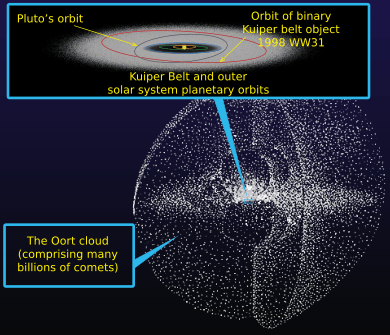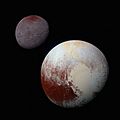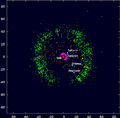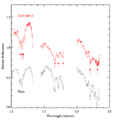Kuiper belt facts for kids

The Kuiper belt (pronounced KY-pər) is a huge, donut-shaped area in the outer Solar System. It stretches out past the orbit of Neptune, from about 30 to 50 times the distance from the Sun to Earth. Think of it like a second asteroid belt, but much, much bigger! It's 20 times wider and can be 20 to 200 times more massive.
This region is filled with many small, icy objects. These are leftovers from when our Solar System first formed. While most asteroids are made of rock and metal, objects in the Kuiper belt are mostly made of frozen "ices." These include frozen water, methane, and ammonia. The Kuiper belt is home to several dwarf planets, such as Pluto, Haumea, Makemake, Orcus, and Quaoar. Some moons, like Neptune's Triton and Saturn's Phoebe, might have come from this icy region too.
Contents
Who Discovered the Kuiper Belt?
The Kuiper belt is named after the Dutch astronomer Gerard Kuiper. He suggested that such a belt might exist in 1951. However, other scientists, like Kenneth Edgeworth in the 1930s, also thought about it. Later, in 1980, Julio Ángel Fernández wrote a paper suggesting a comet belt beyond Neptune. He thought this belt could be the source of short-period comets.
First Discoveries in the Kuiper Belt
In 1992, astronomers found an object called Albion. This was the first Kuiper belt object (KBO) found since Pluto in 1930 and its moon Charon in 1978. Since then, thousands of KBOs have been discovered. Scientists believe there are more than 100,000 KBOs larger than 100 kilometers (about 62 miles) across!
At first, people thought the Kuiper belt was where most short-period comets came from. These are comets that orbit the Sun in less than 200 years. But studies in the mid-1990s showed that the Kuiper belt is actually quite stable. It turns out that most of these comets actually come from a different area. This area is called the scattered disc. The scattered disc was formed when Neptune moved outwards about 4.5 billion years ago. Objects in the scattered disc, like the dwarf planet Eris, have very stretched-out orbits. They can travel as far as 100 times the Earth-Sun distance from the Sun.
Kuiper Belt vs. Oort Cloud
The Kuiper belt is different from the Oort cloud. The Oort cloud is a theoretical region believed to be much, much farther away. It's thought to be a thousand times more distant than the Kuiper belt and shaped like a giant sphere.
Objects in the Kuiper belt, along with those in the scattered disc and the possible Oort cloud, are all called trans-Neptunian objects (TNOs). This just means they are objects beyond Neptune's orbit.
Pluto and the Kuiper Belt
Pluto is the largest and most massive object in the Kuiper belt. It's also the largest and second-most-massive known TNO, only smaller than Eris. Pluto was once considered a planet. But in 2006, its status changed to a dwarf planet. This happened because scientists realized it was part of the Kuiper belt. Pluto is similar in what it's made of to many other Kuiper belt objects. Its orbit is also like a group of KBOs called "plutinos." These objects share a special orbital pattern with Neptune.
The Kuiper belt is often seen as marking the edge of our Solar System. Other ideas for the Solar System's edge include the heliopause. This is where the Sun's wind of particles stops. Another idea is the distance where the Sun's gravity is matched by the gravity of other stars. This is thought to be between 50,000 and 125,000 times the Earth-Sun distance.
Images for kids
-
Astronomer Gerard Kuiper, after whom the Kuiper belt is named
-
The array of telescopes atop Mauna Kea, with which the Kuiper belt was discovered
-
Distribution of cubewanos (blue), Resonant trans-Neptunian objects (red), Sednoids (yellow) and scattered objects (grey)
-
Artist's impression of plutino and possible former C-type asteroid 1202162004 EW
-
The KBO 486958 Arrokoth (green circles), the selected target for the New Horizons Kuiper belt object mission
-
Debris discs around the stars HD 139664 and HD 53143 – black circle from camera hiding stars to display discs.
See also
 In Spanish: Cinturón de Kuiper para niños
In Spanish: Cinturón de Kuiper para niños















